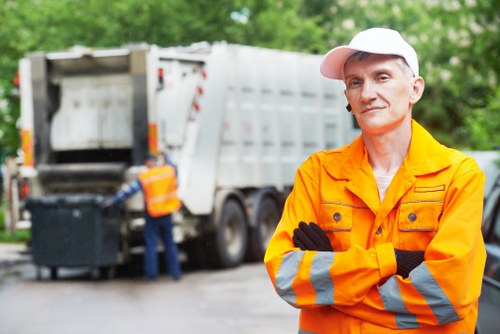Builders Waste Clearance in Bulky Waste Collection
Introduction to Builders Waste Clearance

In the construction industry, effective builders waste clearance is crucial for maintaining a clean and safe worksite. Proper bulky waste collection not only ensures compliance with environmental regulations but also enhances the overall efficiency of construction projects.
Builders waste encompasses a variety of materials generated during the construction, renovation, and demolition processes. These materials can range from concrete and wood to metals and plastics, each requiring specific handling and disposal methods.
Efficient management of bulky waste is essential to minimize environmental impact and promote sustainability within the construction sector. By adopting responsible waste clearance practices, builders can contribute to reducing landfill usage and conserving natural resources.
Types of Builders Waste

Understanding the different types of builders waste is the first step toward effective waste clearance. Common categories include:
- Inert Waste: Materials like concrete, bricks, and tiles that do not decompose.
- Non-Inert Waste: Organic materials such as wood and drywall that can decompose over time.
- Hazardous Waste: Items like asbestos, lead-based paints, and certain chemicals that require specialized handling.
Each type of waste demands specific collection and disposal methods to ensure safety and regulatory compliance. Proper categorization aids in efficient bulky waste management.
Regulations and Compliance

Builders waste clearance is subject to various local and national regulations aimed at protecting the environment and public health. Compliance with these regulations is non-negotiable and involves:
- Proper Segregation: Separating different types of waste for appropriate disposal.
- Permitting: Obtaining necessary licenses for transporting and disposing of bulky waste.
- Reporting: Maintaining accurate records of waste generation and disposal activities.
Adhering to these regulations not only avoids legal penalties but also fosters a reputation of responsibility and reliability within the construction industry.
Environmental Impact of Builders Waste

The environmental consequences of improper builders waste clearance are significant. Improper disposal can lead to:
- Soil and water contamination
- Increased greenhouse gas emissions
- Habitat destruction
By implementing sustainable waste collection practices, builders can mitigate these impacts. Recycling materials, reusing components, and reducing overall waste generation are effective strategies for promoting environmental stewardship.
Moreover, responsible waste management supports the circular economy, where materials are continuously reused and recycled, thereby reducing the demand for new resources.
Methods for Effective Waste Clearance

Implementing efficient builders waste clearance involves several key methods:
Segregation at Source
Separating waste materials during the construction process ensures that recyclable and reusable materials are not contaminated, facilitating easier processing and disposal.
Scheduled Waste Collection
Regularly scheduled waste pickups prevent the accumulation of bulky waste on-site, maintaining a safe and organized workspace.
Use of Specialized Containers
Employing containers designed for specific types of waste can streamline the collection process and enhance overall efficiency.
Benefits of Professional Waste Clearance Services
Engaging professional waste clearance services offers numerous advantages:
- Expertise: Professionals have the knowledge and experience to handle waste correctly.
- Efficiency: Timely and organized waste removal reduces downtime and project delays.
- Compliance: Ensures all regulatory requirements are met, avoiding legal issues.
Additionally, professional services often provide customized solutions tailored to the specific needs of a construction project, enhancing overall effectiveness.
By outsourcing waste clearance, builders can focus on their core activities while leaving the complexities of waste management to the experts.
Choosing the Right Waste Clearance Service
Experience and Reputation
Select a service provider with a proven track record in bulky waste collection. Positive reviews and testimonials indicate reliability and quality of service.
Range of Services
Ensure the company offers comprehensive waste management solutions, including recycling, hazardous waste handling, and on-site consultations.
Cost-Effectiveness
Compare pricing structures and service packages to find a solution that fits your budget without compromising on quality.
Innovations in Waste Management

Advancements in technology are revolutionizing builders waste clearance:
Automated Sorting Systems
Automated systems enhance the efficiency and accuracy of waste segregation, reducing labor costs and increasing throughput.
Real-Time Tracking
GPS and IoT technologies allow for real-time tracking of waste collection, improving logistics and accountability.
Eco-Friendly Disposal Methods
Innovative disposal techniques, such as pyrolysis and bioconversion, minimize environmental impact and promote sustainability.
Cost Factors in Builders Waste Clearance

The cost of waste clearance services can vary based on several factors:
- Volume of Waste: Larger volumes typically incur higher costs due to the need for more resources.
- Type of Waste: Hazardous or specialized waste may require additional handling and disposal fees.
- Location: Remote or hard-to-access sites can increase transportation costs.
- Service Frequency: Regular pickups may offer discounts compared to one-time services.
Understanding these factors can help builders budget effectively and choose a service that offers the best value.
Environmental Benefits of Proper Waste Clearance
Implementing proper builders waste clearance practices yields significant environmental benefits:
Reduction in Landfill Use
Minimizing the amount of waste sent to landfills conserves space and reduces the environmental footprint of construction activities.
Resource Conservation
Recycling and reusing materials help conserve natural resources, promoting sustainable construction practices.
Pollution Prevention
Proper disposal of hazardous waste prevents soil and water contamination, safeguarding ecosystems and public health.
Case Studies: Successful Waste Clearance Projects
Examining successful waste clearance projects can provide valuable insights:
Urban High-Rise Construction
A high-rise construction project in downtown utilized a comprehensive waste management plan, resulting in a 40% reduction in waste sent to landfills through effective recycling and reuse strategies.
Residential Development
A residential housing development implemented regular waste pickups and on-site sorting, leading to improved site safety and cleaner neighborhoods.
Commercial Renovation
A major commercial renovation project partnered with a professional waste clearance service, ensuring timely disposal of bulky items and compliance with all environmental regulations.
Future Trends in Builders Waste Clearance
The future of builders waste clearance is poised for innovation and growth:
- Smart Waste Management Systems: Integration of AI and machine learning to optimize waste collection routes and schedules.
- Increased Recycling Rates: Advancements in recycling technologies to handle a broader range of construction materials.
- Green Certifications: Growing emphasis on sustainable practices leading to more builders seeking green certifications through responsible waste management.
- Collaborative Platforms: Development of platforms that connect builders with waste clearance services, promoting transparency and efficiency.
Staying abreast of these trends will enable builders to enhance their waste management strategies and remain competitive in the industry.
Conclusion
Effective builders waste clearance is integral to the success and sustainability of construction projects. By understanding the types of waste, adhering to regulations, and employing professional waste clearance services, builders can promote environmental stewardship and operational efficiency.
Investing in responsible bulky waste collection not only benefits the environment but also enhances the reputation and reliability of construction businesses. As the industry continues to evolve, embracing innovative waste management practices will be key to achieving long-term success.
Contact us today to learn more about our comprehensive builders waste clearance solutions and how we can support your next construction project.